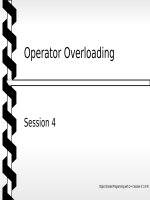Reactive programming with swift 4 build asynchonous reactive applications with easy to maintain and clean code using rxswift and xcode 9
Bạn đang xem bản rút gọn của tài liệu. Xem và tải ngay bản đầy đủ của tài liệu tại đây (9.56 MB, 336 trang )
Reactive Programming with Swift 4
Build asynchronous reactive applications with
easy-to-maintain and clean code using RxSwift and Xcode 9
Navdeep Singh
BIRMINGHAM - MUMBAI
Reactive Programming with Swift 4
Copyright © 2018 Packt Publishing
All rights reserved. No part of this book may be reproduced, stored in a retrieval system, or transmitted in any form or by any means,
without the prior written permission of the publisher, except in the case of brief quotations embedded in critical articles or reviews.
Every effort has been made in the preparation of this book to ensure the accuracy of the information presented. However, the
information contained in this book is sold without warranty, either express or implied. Neither the author, nor Packt Publishing or its
dealers and distributors, will be held liable for any damages caused or alleged to have been caused directly or indirectly by this book.
Packt Publishing has endeavored to provide trademark information about all of the companies and products mentioned in this book by the
appropriate use of capitals. However, Packt Publishing cannot guarantee the accuracy of this information.
Commissioning Editor: Kunal Chaudhari
Acquisition Editor: Isha Raval
Content Development Editor: Flavian Vaz
Technical Editor: Akhil Nair
Copy Editor: Shaila Kusanale
Project Coordinator: Devanshi Doshi
Proofreader: Safis Editing
Indexer: Rekha Nair
Graphics: Jason Monteiro
Production Coordinator: Shraddha Falebhai
First published: February 2018
Production reference: 1210218
Published by Packt Publishing Ltd.
Livery Place
35 Livery Street
Birmingham
B3 2PB, UK.
ISBN 978-1-78712-021-1
www.packtpub.com
mapt.io
Mapt is an online digital library that gives you full access to over 5,000 books and videos, as well as
industry leading tools to help you plan your personal development and advance your career. For more
information, please visit our website.
Why subscribe?
Spend less time learning and more time coding with practical eBooks and Videos from over
4,000 industry professionals
Improve your learning with Skill Plans built especially for you
Get a free eBook or video every month
Mapt is fully searchable
Copy and paste, print, and bookmark content
PacktPub.com
Did you know that Packt offers eBook versions of every book published, with PDF and ePub files
available? You can upgrade to the eBook version at www.PacktPub.com and as a print book customer, you
are entitled to a discount on the eBook copy. Get in touch with us at for more
details.
At www.PacktPub.com, you can also read a collection of free technical articles, sign up for a range of free
newsletters, and receive exclusive discounts and offers on Packt books and eBooks.
Contributors
About the author
Navdeep Singh is a result-oriented software developer and research professional with more than 7
years of experience in both development and research positions. He strives to create software with
the user in mind, creating applications with a usable and intuitive user interface experience. Navdeep
spends most of his time learning about the latest trends in technology, writing blogs, playing cricket,
or practicing classical Hindustani music.
Firstly, I would like to thank the Almighty, who gave me insights to follow this path of sharing
knowledge. Thanks to my beloved wife, who has been in my life for less than a year and has been
an inspiration for pushing me to spend hours writing this book, my parents and my family who
believed in me right from the start till this very moment.
About the reviewer
Kevin Munc (@muncman) is a 20-year programming veteran with wide experience, from mainframes to
mobile. Along the way, he's reviewed books on Objective-C, watchOS, UIAutomation, Sprite Kit,
JavaFX, and Vim.
I’d like to thank all my colleagues —past and present— who have helped me sharpen my reviewing
skills. I’m also thankful for the ongoing support of my family as I continue chasing new tech.
Packt is searching for authors like you
If you're interested in becoming an author for Packt, please visit authors.packtpub.com and apply today.
We have worked with thousands of developers and tech professionals, just like you, to help them
share their insight with the global tech community. You can make a general application, apply for a
specific hot topic that we are recruiting an author for, or submit your own idea.
Table of Contents
Title Page
Copyright and Credits
Reactive Programming with Swift 4
Packt Upsell
Why subscribe?
PacktPub.com
Contributors
About the author
About the reviewer
Packt is searching for authors like you
Preface
Who this book is for
What this book covers
To get the most out of this book
Download the example code files
Download the color images
Conventions used
Get in touch
Reviews
1.
Migrating from Swift 3 to Swift 4
What's new in Swift 4?
Setting up the environment
What’s changed?
Changes/improvements in Dictionary
Grouping initializer
Key-based subscript with default value
Convert tuples to Dictionary
Convert arrays to Dictionary
Resolving duplicates
Reserving capacity
Changes/improvements in Strings
Bid bye to string.characters
String protocol
Changed interpretation of grapheme clusters
Access modifiers
What's new
JSON encoding and decoding
Multiline String literals
Smart key paths
One sided ranges
Pattern matching with one sided ranges.
swap versus swapAt
Improved NSNumber
Directly access unicode scalars of characters
Migrating to Swift 4
Preparation before migration
Swift migration assistant
Swift 4 migration changes overview
SDK changes
Notable special cases
New String
Differentiating between single-tuple and multiple-argument function types
Adding tuple destructuring
Default parameter values must be public
After migration
Known migration issues
Using Carthage/CocoaPods projects
Summary
2.
FRP Fundamentals, Terminology, and Basic Building Blocks
Functional reactive programming
What is functional reactive programming (FRP)?
Imperative programming
Functional programming
Reactive programming
Basic building blocks
Event streams
State
Side effects
Immutability
RxSwift foundation
Reactive extensions
Observable
Subject
Marble diagrams
Schedulers
Railway-oriented programming
Summary
3.
Set up RxSwift and Convert a Basic Login App to its RxSwift Counterpart
RxSwift in action
Let's build the environment first
Setting up the environment
RxSwift with CocoaPods
Installing RxSwift
Installing RxSwift with Carthage
Let's get started – The Login page
Setting up
Steps to set up
Functional programming to the rescue
Summary
4.
When to Become Reactive?
Creating and subscribing to Observables
Project setup
Getting started
Different types of subject
PublishSubject in action
BehaviorSubject in action
ReplaySubject in action
Variable in action
Understanding traits and its types
What are traits?
Different types of trait
The single trait
The completable trait
The maybe trait
Summary
5.
Filter, Transform, and Simplify
Working with events using operators
Environment setup
Transforming operators
flatMap and flatMapLatest in action
Scan, reduce, and buffer
Scan
Buffer
Filtering operators
The filter operator
The distinctUntilChanged operator
The takeWhile operator
Summary
6.
Reduce by Combining and Filtering and Common Trade Offs
Combining and filtering Observable sequences
Project setup
Concatenating and prefixing
Merging
Combining elements of different types
Introducing zip
Performing side effects
doOn in action
Setting the project
Building the app
Summary
7.
React to UI Events – Start Subscribing
RxCocoa traits
Types of RxCocoa traits
Driver
ControlProperty
ControlEvent
Binding UI elements in practice
Binding data to UI
Binding UITableViews
Configuring cell rows in a TableView
Selecting a row in TableView
Binding UICollectionViews
Summary
8.
RxTest and Custom Rx Extensions – Testing with Rx
Testing in RxSwift
RxTest
Testing in practice with HotObservables
Testing in RxTest with ColdObservables
RxBlocking
Testing with RxBlocking
Summary
9.
Testing Your RxCode – Testing Asynchronous Code
Tracking down issues – Debugging Rx code
Debugging with debug
Debugging with total
Testing asynchronous code
Summary
10.
Schedule Your Tasks, Don't Queue!
Queues and schedulers
Scheduler Singletons
Specifying a scheduler
Schedulers in practice
ConcurrentDispatchQueueScheduler
SerialDispatchQueueScheduler
OperationQueueScheduler
Summary
11.
Subscribe to Errors and Save Your App
Error handling
The catchErrorJustReturn operator
The catchError operator
The retry operator
onErrorJustReturn
onErrorDriveWith
onErrorRecover
Summary
12.
Functional and Reactive App-Architecture
Design patterns
Singleton design pattern
Implementation
Singleton design pattern – Pros and cons
Key value coding (KVC)
KVC – Implementation
Notifications
Notifications – Implementation
Model view controller – MVC
The model
The view
The controller
MVC implementation
Summary
13.
Finish a Real-World Application
Networking in RxSwift
Project setup
Project implementation
Fetching and parsing data
Binding fetched data to View elements
Build and run
Some other cool libraries
Summary
Other Books You May Enjoy
Leave a review - let other readers know what you think
Preface
As a platform, iOS offers numerous APIs to write asynchronous code and, many a times, this choice
becomes hard to manage and a single code base ends up comprising multiple Asynchronous API
usages, for example, closures for small Async tasks, delegation for background tasks, notification
center for event-based tasks, and such. Managing and modifying such a code base might become a
headache even if it is written in the best way possible, and the problem becomes more severe if a big
team is involved with a single code base. RxSwift brings in uniformity so that different types of
requirements (mentioned earlier) are handled with RxSwift code and hence you, as a developer, get
more control over the processes and different module interactions within the app.
The main mission of this book is to give you a platform to catapult your skills to be on par with
the best RxSwift developers out there. Follow the content in the book as per the schedule, and rest
assured that you will achieve the mission.
Who this book is for
This book is for iOS developers who have intermediate knowledge of Swift development for IOS and
want to take their skill set to the next level. RxSwift offers more control over asynchronous code in
your iOS environment, and, as a seasoned developer, even a slight advantage to the way
asynchronous code is written is always welcome. This book will challenge the way you have been
thinking about your apps' logic and guide you along the way as you turn the tables and start thinking in
a more declarative way as compared to the traditional imperative way. In short, you will learn how to
think in “what to do” terminology as compared to “how to do.”
For those who are eager to become a Swift Ninja, this book aims to work in a slightly unique manner
—we will dive straight into the code, and as we build on the demo applications, we will explain the
concepts “on the fly,” as they say! Development is all about practice, and this book abides by that rule
right from the word go.
What this book covers
, Migrating from Swift 3 to Swift 4, teaches what’s new in Swift 4 and how you can
transition your code from Swift 3 to Swift 4. Unlike the previous Swift releases, this time the
conversion is more seamless, and you will see this in practice with the help of an example.
Chapter 1
, FRP Fundamentals, Terminology, and Basic Building Blocks, takes you through FRP and
its basic building blocks, marble diagrams, and sequence diagrams to understand more about
sequences and events in brief. Finally, the chapter will unleash Railway-oriented programming and a
brief introduction on error handling in FRP.
You will learn how you can handle errors in one single place without having to care about handling
errors at every single event.
Chapter 2
, Set up RxSwift and Convert a Basic Login App to its RxSwift Counterpart, explains that the
best way to get the feel about any topic is practice. This chapter will take a nosedive into the RxSwift
world by converting an existing Swift app into RxSwift. You will see the RxSwift syntax for the very first
time in this chapter and get to work with a real-world application.
Chapter 3
You will get a feel of how to convert an existing code base into a RxSwift code base and compare the
benefits of the newly learned reactive concepts.
You will note the increased readability and concise but clear code that can be written using the RxSwift
library when compared to normal Swift. The gist of this chapter is to provide you with a comparison
to understand the benefits that RxSwift code brings into play.
, When to become Reactive?, helps you to use your armor judiciously, as it might lead to
increased complexity if not used in a proper setting. When writing any code, keep in mind that the
best code might not be the smartest code out there, rather, the best code is the one that is easier to
maintain and understand. This chapter will brief you about when to use RxSwift in your application.
You will also work with playgrounds to understand some more core concepts that enable you to
simplify your complex code base.
Chapter 4
, Filter, Transform, and Simplify, along with the next chapter, teaches you how to apply
operators to filter out events and then proceed to handle them. You will play with major building
blocks of RxSwift and note the clarity and control that you get as compared to normal Swift code while
dealing with event-driven concepts. In this chapter, you will work with Playgrounds to transform
sequences by filtering them using map, flatmap, and other such operators as they are generated so that
you can take respective actions as per the type of the event that is generated.
Chapter 5
, Reduce by Combining and Filtering and Common Trade Offs, might sound tedious to read
at first, but the concepts will get more clear as we practice with real examples. In this chapter, you
will work with some more transforming operators to reduce the observable data stream by making
use of combining and filtering operators in conjunction and then gradually work your way to know
Chapter 6
other operators, such as mathematical and time based.
You will also read about the trade-offs while incorporating these operators in your code so that you
can be careful while making the choice to go reactive.
, React to UI Events – Start Subscribing, introduces you to another framework, which is part
of the original RxSwift repository—RxCocoa.
Chapter 7
Convert your simple UI elements such as UIButtons and UITextFields to Reactive components. You will
learn how to subscribe to events emitted by your newly created reactive UI components and perform
respective actions depending on the type of the event. For instance, a UIButton might have a touchUpInside
or long press event, and you might want to respond to both the events differently.
This chapter will also introduce you to some reactive networking code and how you can subscribe to
events while your code is interacting with API calls.
, RxTest and Custom Rx Extensions – Testing with Rx, discusses RxTest, and later, RxBlocking,
by writing tests against several RxSwift operations and also writing tests against production RxSwift
code. Also, you will create an extension to NSURLSession to manage the communication with an endpoint.
Chapter 8
, Testing Your RxCode – Testing Asynchronous Code, says that almost every IOS app needs
some sort of API access to fetch or save data over cloud to complete its workflow and hence it
becomes important to test code that interacts with APIs. Since response from APIs is uncertain and
error prone, the code that interacts with APIs should be tested rigorously before shipping with
production code. This chapter introduces you to concepts such as mocking, stubbing, dependency
injections, and expectations and sheds some light on how you can substitute your live APIs with
dummy data.
Chapter 9
You will also know how to continue development even when your API is not ready and, as a result,
fasten your sprints.
, Schedule Your Tasks, Don't Queue!, informs that in traditional Swift, there are different
ways to handle concurrency—GCD, Operational Queues, and so on. This chapter introduces you to
the concept of schedulers. RxSwift encourages a developer not to work directly with locks or queues,
and 99% of the times, you will be encouraged to use platform-provided schedulers rather than
creating custom schedulers.
Chapter 10
, Subscribe to Errors and Save Your App, describes that it does not take long for negative
inputs to pour in when an app with users in production shuts down abruptly. This chapter will cover
the beauty behind error handling in RxSwift. You can subscribe to errors and react to different types of
errors either in one way or follow a specific path for specific errors, for instance, retrying if a
download failed abruptly, reauthenticating a user behind the scenes if the session has expired, and so
on.
Chapter 11
, Functional and Reactive App-Architecture, compares different design patterns that can be
Chapter 12
used while writing RxSwift apps from scratch or modifying current apps to incorporate Reactive and
functional behavior. You will know about observation, iteration, delegation, MVC, and MVVM and
try to figure out which design pattern fits the puzzle in the best way possible. This chapter will also
introduce you to different open source APIs that can be incorporated to your ongoing projects.
, Finish a Real-World Application, concludes that you would have covered a lot so far and
worked on a lot of code examples; now, you will put everything that you have learned so far to
practice in one place and finish an app that we started earlier in Chapter 2, FRP Fundamentals,
Terminology, and Basic Building Blocks. This chapter will cover the MVVM application
architecture and show how a well-designed ViewModel can power an RxSwift app.
Chapter 13
To get the most out of this book
We assume that you, the reader of this book, already have intermediate knowledge of Swift
programming language and have worked on iOS applications before.
Download the example code files
You can download the example code files for this book from your account at www.packtpub.com. If you
purchased this book elsewhere, you can visit www.packtpub.com/support and register to have the files
emailed directly to you.
You can download the code files by following these steps:
1.
2.
3.
4.
Log in or register at www.packtpub.com.
Select the SUPPORT tab.
Click on Code Downloads & Errata.
Enter the name of the book in the Search box and follow the onscreen instructions.
Once the file is downloaded, please make sure that you unzip or extract the folder using the latest
version of:
WinRAR/7-Zip for Windows
Zipeg/iZip/UnRarX for Mac
7-Zip/PeaZip for Linux
The code bundle for the book is also hosted on GitHub at />-4-Programming. We also have other code bundles from our rich catalog of books and videos available
at Check them out!
Download the color images
We also provide a PDF file that has color images of the screenshots/diagrams used in this book. You
can download it here: />rImages.pdf.
Conventions used
There are a number of text conventions used throughout this book.
: Indicates code words in text, database table names, folder names, filenames, file
extensions, pathnames, dummy URLs, user input, and Twitter handles. Here is an example: "Setting up
an RxSwift environment"
CodeInText
A block of code is set as follows:
use_frameworks!
target 'YOUR_TARGET_NAME' do
pod 'RxSwift'
pod 'RxCocoa'
end
Any command-line input or output is written as follows:
sudo gem install cocoapods
Bold: Indicates a new term, an important word, or words that you see onscreen. For example, words
in menus or dialog boxes appear in the text like this. Here is an example: "Now pick the recently
installed Swift 4.0 Snapshot and restart Xcode IDE"
Warnings or important notes appear like this.
Tips and tricks appear like this.









